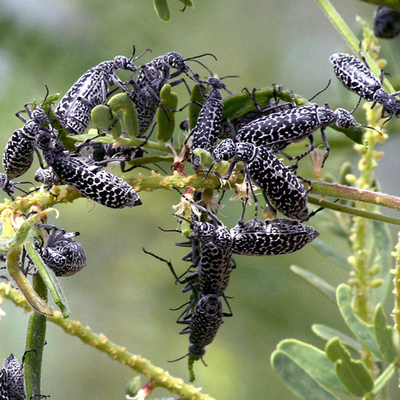Quick facts
- Blister beetle-infested hay can cause health problems and death in horses and other livestock.
- When buying hay from outside of Minnesota, find out where and when hay was harvested.
- If you see black, elongated beetles in hay bales, do not feed to animals and throw it away carefully.
When local hay is in short supply, many horse owners buy hay from outside Minnesota and the Midwest. Buying alfalfa hay from out of state increases the risk of getting hay infested with blister beetles. While rare, blister beetle-infested hay can cause health problems and death in horses and other livestock. If you find black, elongated beetles in your hay, dispose of it.
How to identify blister beetles
Blister beetles are black, elongated insects that are attracted to and feed on the flowers, pollen and leaves of blooming alfalfa and weeds. Developing beetles feed on grasshopper eggs, so blister beetles are often found in alfalfa produced in arid southern states and plains states where grasshoppers are more of a problem.
- Adult blister beetles are long, narrow beetles (0.5 to 1.25 inches long) with a broad head and antennae that are straight and about one third their total body length.
- Several species exist, including black, ash gray or striped beetles, each having unique color patterns.
Poisoning from blister beetles
- Blister beetles naturally produce a compound called cantharidin.
- The level of cantharidin produced is highly variable and released when the beetle is crushed during hay making. Cantharidin remains toxic in dead beetles and the level of toxin does not decrease during hay storage.
- Symptoms in horses include sores or blisters on the tongue and in the mouth, colic, straining, increased temperature, depression, increased heart and respiratory rates, dehydration, sweating, diarrhea, bloody feces and frequent urination.
- If cantharidin poisoning is suspected, contact your veterinarian immediately.
- There is no specific antidote beyond supportive care, which includes mineral oil, intravenous fluid therapy, activated charcoal and analgesics.
Know where your hay comes from
- Blister beetles are rarely found in Minnesota and Midwestern states.
- When buying hay, learn as much as possible about who produced it, where it was produced, when it was cut and maturity at harvest.
- If details aren't available, pay close attention to alfalfa hay that was mature or flowering when harvested.
- Detecting blister beetles in hay is practically impossible because the beetles tend to swarm. This means that only a few bales or parts of bales from an entire field may be infested.
- Beetles are very difficult to spot in bales. You may be able to see some dead, crushed beetles in small square bales.
- Discard any bales with beetles.
Minimize the risk
In locations with a history of blister beetles, the risk cannot be eliminated, but it can be minimized during harvest.
- Blister beetle populations are usually low until mid-summer (August), so earlier cuttings of alfalfa tend to have minimal infestations.
- Beetles are more likely to be found in flowering alfalfa hay and when grasshoppers are present.
- Hay that is simultaneously cut and crimped with a mower conditioner is more likely to kill beetles, keeping them in the windrow. However, crimping speeds drying, which is important for harvesting high quality hay.
- Cutting alfalfa at less than 10% bloom reduces the number of beetles; but hay cut at this maturity is often too nutrient dense for most horses.
- Farmers should watch for beetle swarms during harvest and stop harvesting to allow the beetles to disperse.
- Chemical control is not the best option because dead beetles may still end up in hay.
- Farmers should practice integrated pest management, which includes scouting for beetles and grasshoppers and controlling weeds. See Alfalfa insects: What to look for and how to scout.
Infestation is rare
It's doubtful a hay producer would purposefully bale alfalfa hay infested with blister beetles. Horse owners should not be afraid to purchase alfalfa hay from the Midwest, or even the more arid states, as long as both buyers and sellers practice due diligence and are aware of the rare potential for blister beetle toxicity.
Reviewed in 2024


